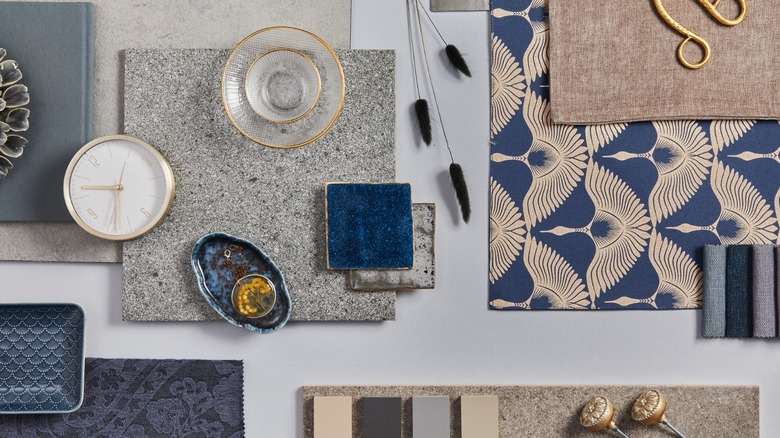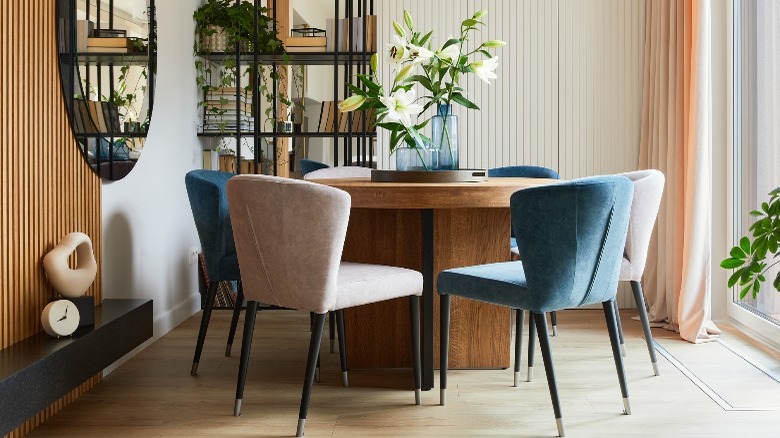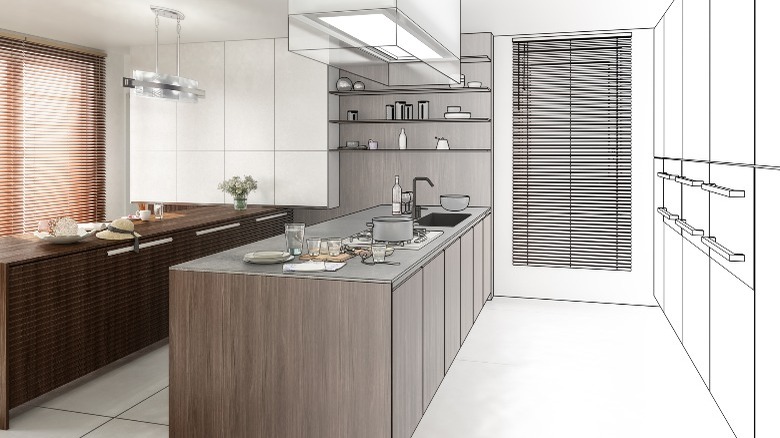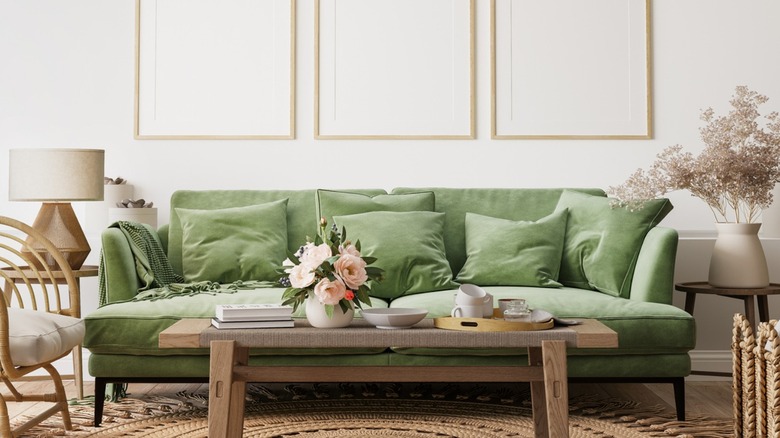Interior Decorator Vs. Interior Designer: What's The Difference?
Decorator and designer — there are few terms bandied about with such indiscrimination. Both professions provide services centering on the nuance of aesthetics and certain fundamental concepts regarding balance, proportion, and color. They can each guide you through the processes of selecting furniture, fabrics, fixtures, and finishes — all essential considerations when implementing renovations or redefining a space.
To the interior designer, and client perhaps, a distinction between labels is important. In some states, a license is required to practice while in others, it's optional but still offers a protected title. A designer frequently works with architects and contractors, while a decorator may or may not have equal expertise regarding construction; they make a profession of their knowledge and application of decorative arts, no certification necessary. Chron describes the difference as a structural one: If it involves planning interior layouts, you'll want a designer; for cosmetic treatments, a decorator might suffice. This leads to qualification and cost variables but is not entirely indicative of quality, style, or client satisfaction.
Education and credentialing for interior designers
Most designers enroll in a four-year interior design program where they receive an education on such subjects as furniture construction, space planning, architecture, and color theory, as explained by The Spruce. There are accreditation and preparation courses available for those with a related bachelor's degree, like studio art and graphic design.
Requirements for licensure include the completion of a rigorous exam called the National Council for Interior Design Qualification (NCIDQ). For test eligibility, the candidate must possess the equivalent of up to four full-time years of employment in their field and a relevant bachelor's degree. Proficiency is demanded in residential, commercial, and environmental design, safety and building code regulations, space planning, and sophisticated planning software. In order to fulfill the work requirement for licensing and to gain experience, many graduates will apprentice under the tutelage of an established designer.
Residential interior designers can seek certification from the Designer Society of America, which is obtained after completion of the Residential Interior Design Qualifying Certification (RIDQC). This nationally recognized exam is available to candidates meeting education requirements and a minimum of seven years of practice; it further verifies core competencies in the principles of interior design.
Education and credentialing for interior decorators
There are no credentialing or education requirements for the practice of interior decorating, nor to utilize the title professionally. That being said, one can opt for qualification through Certified Interior Decorators International, which is a globally recognized association, and the only one, that can bestow the exclusive trademark of its namesake, Certified Interior Decorator (CID).
To become certified, Best Accredited Colleges explains that the decorator must complete an approved program at an accredited school, which focuses on design, lighting, color theory, furniture styles, and room layout, with additional expertise in CAD (Computer-Aided Design). The coursework could span several months of full-time study. Finally, one must pass the CID exam and maintain a membership with Certified Interior Decorators International.
What does it cost to hire a decorator or designer?
HomeGuide claims that the fee for an average residential interior design is approximately $5,500. The total cost depends on the project, square footage, and hours worked. Hourly rates usually range from $50 to $500, and everything purchased by the designer is also added to the overall cost at an agreed-upon margin. According to Decorilla, this covers travel, site visits, shopping time, client communication, relevant work, and sometimes finishings and furniture. Certified Interior Decorators International adds that because of less education and looser credentialing requirements, the rates of a decorator may be lower than those of a designer.
Some designers will provide a consult for one room and then offer solutions and floor plans for the client to implement themselves in the rest of the home. Other assignments are carried out from pre-build to completion, including the final placement of soft furnishings and accessories. Per The Spruce, experienced and sought-after design professionals, as well as those in metropolitan areas, typically cost more. Differences in project scope and location mean resulting expenditures can vary widely, and it's imperative to clarify all associated costs in the initial consultation.
Pros and cons
Though hiring a decorator can seem like a costly endeavor, it's worth noting that it's like any other service for which we pay an expert for their knowledge, experience, and connections. Utilizing the talents of a decorator can be a great investment for our homes (the largest asset for most of us) and ourselves; design changes the functionality of environments and how we absorb them.
The Spruce explains that design professionals maintain contacts and relationships with vendors and craftsmen; they are admitted entrance to trade shows and wholesale markets. In other words, they are a liaison to the industry, with a pulse on emerging products — a homeowner with great style and a DIY attitude will not have the same access to resources. Per HGTV, commissioning a designer can reduce the stress and burden of organizing and carrying out a decorating project, while also saving you money by avoiding the folly of costly mistakes.
Of course, there is always the possibility of being unhappy with the results, especially considering the subjectivity and personal nature of designing a home. Open communication and a collaborative relationship are paramount throughout the development of the spaces in question.
In-person services
An interior designer is specifically trained to understand the psychological impacts of design in a given environment. According to the New School of Architecture & Design, they work in tandem with the architect and contractors to ensure functionality, flow, and efficiency. They are a touchpoint for design perceived below consciousness: acoustics, accessibility, and safety. Designers most often work on commercial projects but may offer residential services, which include managing contractors and supervising installations.
Interior decorators are generally onboarded once a structure is complete. Their job is to consider the aesthetics within a space's inherent functionality.
Designers and decorators are qualified to affect stylistic and color palette decisions regarding finishes, furnishings, accessories, and artwork. Both are skilled in the conceptualizing and implementation of space planning, including computer-created schematics, which aid greatly in the visualization of a project.
Online and retail services
When decorating an existing space, virtual design might be a good option for those who have a very strong sense of their style, want little help, or desire more control over the process. HGTV explains that virtual design packages often offer a remote consultation resulting in a set of shopping directives, 3D renderings linking ready-to-purchase pieces, and the management of furniture orders and delivery. Some even recommend paint colors, wallpaper, and window treatments. A design is created utilizing style quizzes, photographs of the room, and dimensions. Generally offered as a tiered structure, some design packages incorporate video and phone communication, as well as a specified number of revisions. Starting at $49, virtual design services are tailor-made for the DIYer and those on a restricted budget.
Many furniture retailers provide free design services within a limited capacity, helping with the selection of frames, fabrics, and wood finishes; some offer in-home appointments and assist with floor layout as well. Few others extend full-scale services, including carpet, drapery, and bed linen customization.
Virtual designers are not required to hold credentials, though some may opt for certification nonetheless — especially those associated with a well-established business or one with high-ticket items.
Which should you choose?
So, which services are best for you? It really depends on the scope of work, budget, and your desired level of involvement. For projects concerning construction or structural changes, an interior designer is the appropriate choice. Furthermore, their expertise in the functionality of environments and aesthetics can bring your dream space to fruition.
For cosmetic and artful updates, consider a decorator. Several revered and famous designers are actually decorators in the context defined here, including Kelly Wearstler, Jonathan Adler, Nate Berkus, and Joanna Gaines, according to My Move. Many of them have had distinctive career paths and schooling that inform their very individualistic points of view — a graphic designer, a potter, a fashion design intern, and a shopkeep, respectively.
Due diligence is imperative when hiring any professional service. For instance, you will need to inquire about their credentials, degree of experience, and rates of customer satisfaction. Barring any qualification restrictions, each designer provides a unique collection of strengths and sensibilities, and their portfolio is the true litmus test.







